
Kitchen Island, Barn Power – March 2024 Update
Welcome to my shop! This is a quick update to let you know what I’ve been up to. This big chunky thing is the leg

I picked up 3 12′ long 8/4 boards of thermally modified ash from Wood From the Hood in Minneapolis. I of course did my best to lay out my parts to get the best grain possible like the grain following the curve of the crest rail and the goofy bend thing in the front leg.

Thermally modified woods have been around for a while mostly in the building industry where it’s primarily used for decking. The thermal modification process involves heating the wood in an oxygen free environment so it can’t combust. This baking makes the wood very stable, rot, insect, and resistant, and imparts a darker color. This final color can be controlled by the baking temperature. The wood I’m using is a lower temp bake which makes it more of a brown. Higher temp bakes produce almost a black color. The downside to this processing is the wood becomes more brittle resulting in potential chipping and splintering while working. That’s not a huge deal though if your blades are sharp and your cuts are supported.

I’m going to start construction with the side assemblies. I’ll cut the rails and leg blocks to length and set the rails aside for later while I focus on the legs. To start forming the rear legs, I’ll cut a wedge off to establish the sloped back rest. Then I can make a couple of stopped rip cuts to begin separating the first leg from the block. Due to the curvature of the blade, there’s a bit of material remaining before the leg will separate. I’ll complete the cut at the bandsaw and remove the extra waste with a chisel. Now I can repeat the process to separate the next leg from the block.
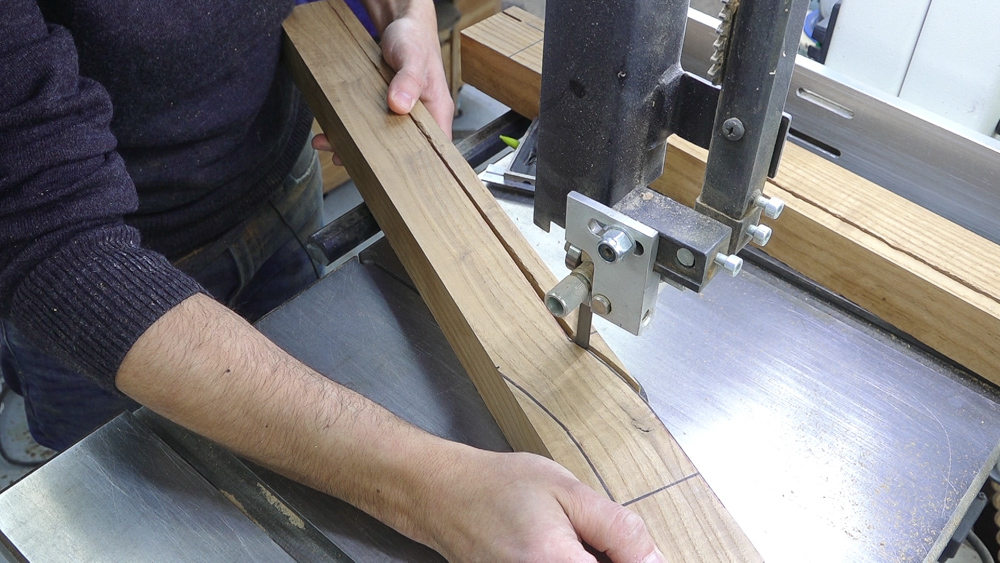
With the rear legs out of the way, I can move on to making the front legs. These have this offset detail, so I’ll set the saw up to make the straight cuts and connect them with the curve at the bandsaw. I’ll use the oscillating sander to refine the curves and do a bit of clean up and blending work with some hand tools.
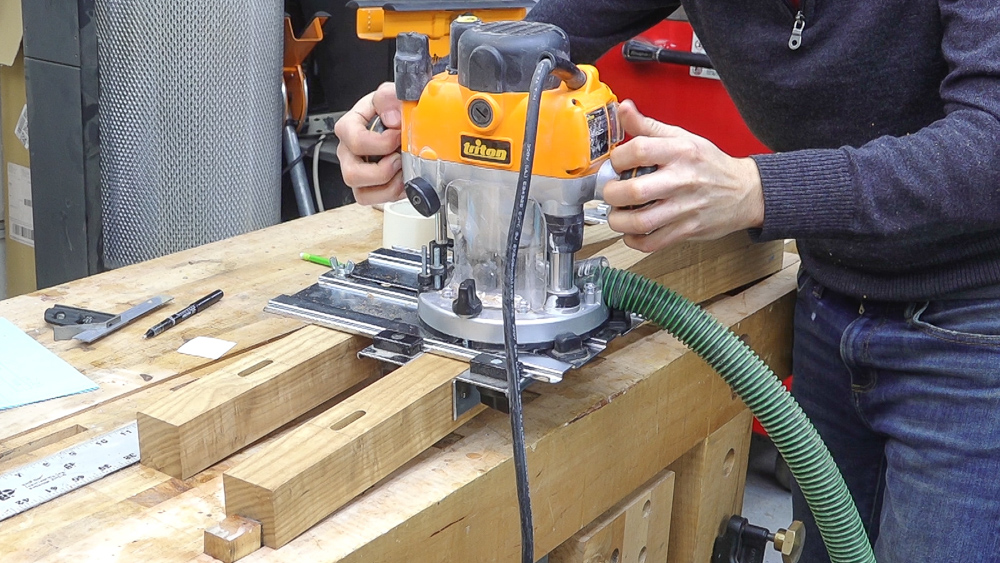
On to the joinery! The bench will be joined with mortise and tenons. I’ll start but cutting all the mortises into the legs for the rails – I’ll take care of the mortise for the arm rest later. Normally, I’m more of a mortiser guy but I decided to give router cut mortises a shot for the project. I have a few of these Triton routers so I grabbed a fence off of another routers edge guide to create a mortise guide. The two fences around the part so the router can only move forward and back and can’t move side to side. Takes most of the uncertainty out of the operation. Some of these mortises required a bit of creativity to keep the router positioned but I worked through all of them without issue.

Now I can get started on the tenons and I’m starting with the easy ones that will make up the side assemblies. I like to score the tenon shoulders first before clearing out the bulk of the waste with the dado blade and then finish cleaning things up with a chisel. This ensure a nice crisp shoulder and is especially helpful with this thermally modified wood which is more brittle than normal wood and has a higher chance of chipping. Next I can take care of the long connecting rails. The process for cutting these is very similar to the others however, these tenons are offset in the part’s thickness. After the tenons are formed to thickness, the various cuts to cut them to width can be made.

Before these things fit into their mortises, the corners need to be removed to fit the rounded ends of the mortise – the only downside of router cut mortise. Luckily this is purely a utilitarian thing.

Lastly, several of these mortise intersect so to make the tenons fit, I’ll cut a 45 degree bevel on the tenons.

Next I’ll add the arm rests starting with the joinery. I’ll start with the mortises. The arm rest block gets a mortise cut in the underside where it will connect to the front leg. A mortise is added to the rear leg which will receive the back of the arm rest.

At the table saw, I’ll away the excess material where the front leg will go and then I’ll work on creating the tenon on the top of that front leg.

The odd shape of the leg requires a spacer to be used on half of the cuts.

Next I’ll start forming the angled tenon on the back of the arm rest. I’ll scribe the shoulder with a knife using my bevel gauge and square to wrap the shoulder line all the way around. I’ll roughly form the tenon with the dado blade, staying a bit away from the line and I’ll cut it to width at the bandsaw.

Before cleaning up the tenon, I’ll shape the arm rest using a template I made of my design.

Once that shaping is done, some chisel work finishes things up and I can test assemble the side assemblies.

Next I’ll add the backrest starting with cutting a curve into the crest rail. I’ll make the rough cut at the bandsaw and fair the curves with a compass plane.

The back slats are going to go up into the crest rail so I’ll start that joinery by creating a groove on the underside of the crest rail with a slot cutter.

Now I can make all of those back slats – 14 of them to be exact. Except I made several extras just in case.

With those out of the way, I can start working on the mortises in the lower rail. I’ll use a divider to space them out and then use the router to create all 14 mortises in 12 minutes.

Now it’s time for tenons. The bottom of each slat receives a tenon to fit into those mortises. Same process here as all the other tenons – there’s just a lot of them.

With things assembled, I can mark where the slats will go into the crest rail and cut them to length. Now I can fill the space between each slat in the crest rail with a block. I used the offcut from the curve for this so I’d end up with similar color and grain. I’ll align each slat correctly, cut a spacer of the correct length and glue it into place.
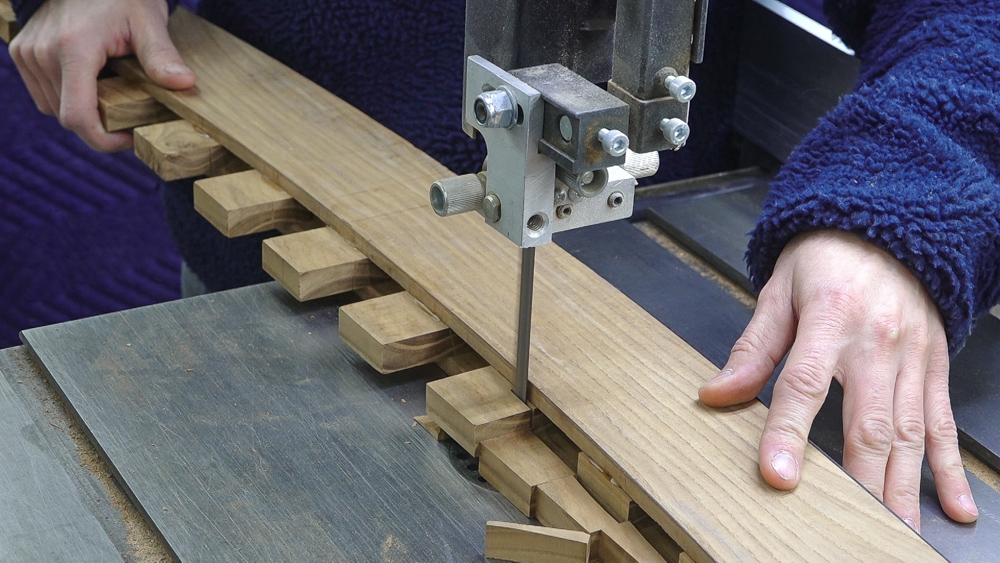
Once the glue is set, the excess can be cut and flush trimmed away.
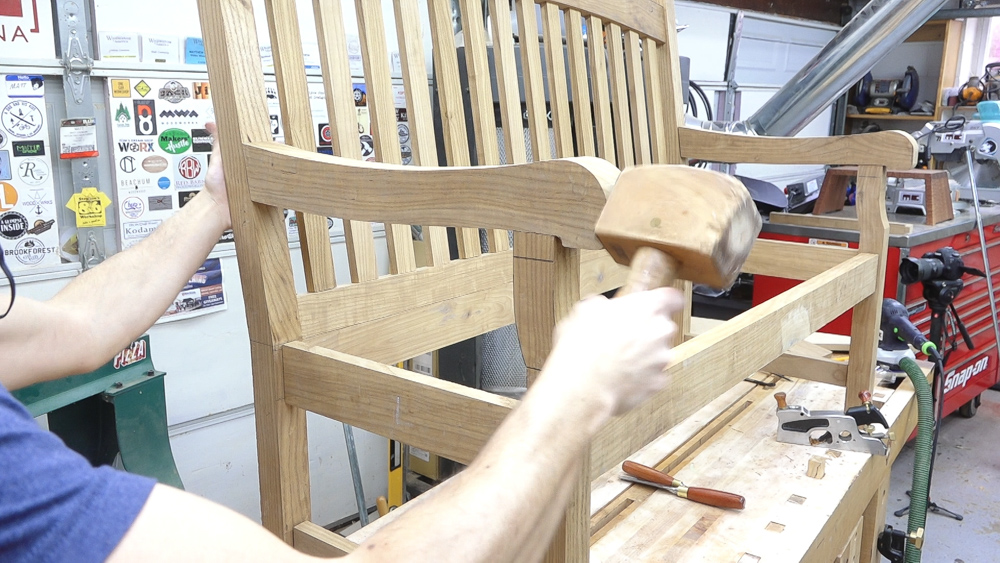
And while things are disassembled, I’ll cut the bevels on the two lower rails.

Now I can take care of the seat area. I’ll start by creating the double mortise and tenon joint that will attach the middle seat support. Due to the orientation of the parts, there isn’t a whole lot of long grain to long grain glue surface so splitting the tenon into two, doubles that glue surface into something closer to significant. This is essentially a box joint in the middle of the board. With those mortises out of the way, I can make the mating tenons on the seat support.

Next these seat supports get a little curve so the seat will conform to a curvy booty and be comfortable. I’ll cut and fair one of them and then use it as a template to route the other two exactly the same.

Now I can break down the stock for the seat slats – a little bit of jointing, planing, and resawing. I’ll start the install but cutting the front slat to length and ripping it to width. Next the rear slat gets a bevel ripped on the rear edge which matches the lean of the backrest.

The rear slat then joins the others to be squared up and trimmed to final length. The rear slat then gets notched so it fits around the rear legs and the slats get ripped to final width.
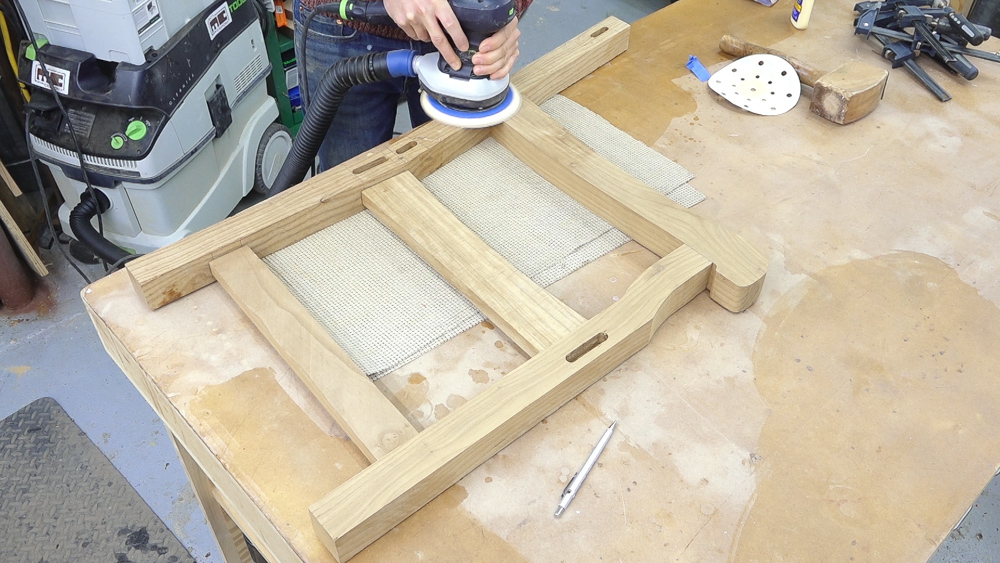
That takes care of construction so it’s on to finish prep. I’ll be prefinishing all the parts before glue up so I’ll work through the sanding process with the thought in mind that I will no be able to adjust anything once the bench is glued up. Parts in the side assemblies come together flush so I’ll sand those dry assembled. On these parts I also need to be careful of edge treatment – I don’t want to break any edges which will intersect another part. So again, I’ll break edges with the side assemblies dry assembled.

I like a more squared off edge look so I’m just lightly breaking the edges by hand. This produces roughly a 1/16” round over.

Also while I have everything taken apart, I’ll drill countersunk holes in the seat support for the screws which will attach the seat slats.

I can also take care of gluing the two lower rails together at this point so they go through finishing as one part. I’ll side on the legs to help keep things aligned. The bottoms of the legs receive an epoxy coating so they don’t wick moisture from the ground.

And the last bit of finish prep is to mask off the tenons.
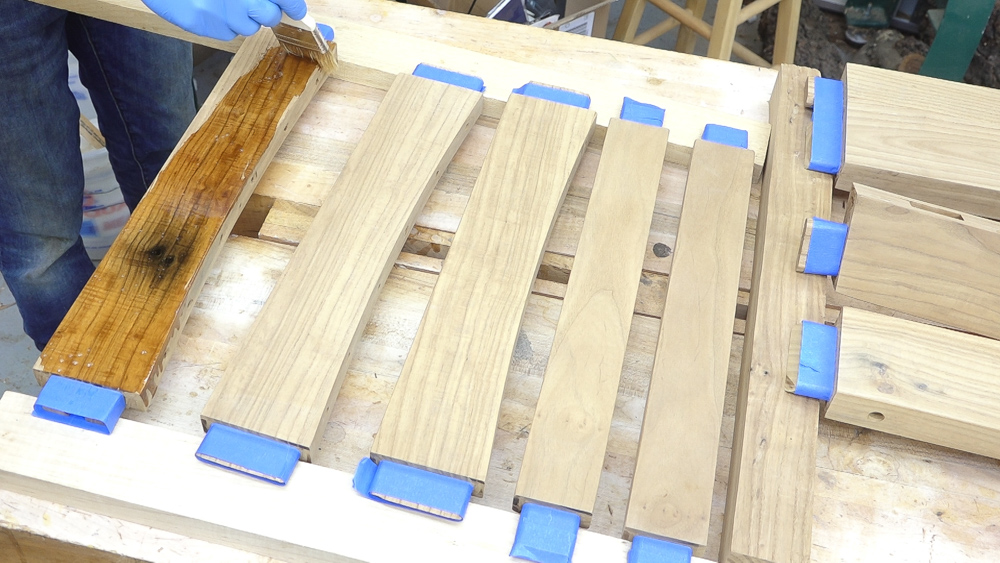
Now I’m ready for a finish. I went with a simple teak oil for this project since this thermally modified wood is already such a great outdoor wood. The finish will bring out the color of the wood and offer a bit of UV resistance. It will also be easy to maintain in the future as refresher coats can easily be applied.

This oil just gets flooded on and is allowed to soak in for 20 min at which point any excess finish still on the surface can be wiped away with a rag.
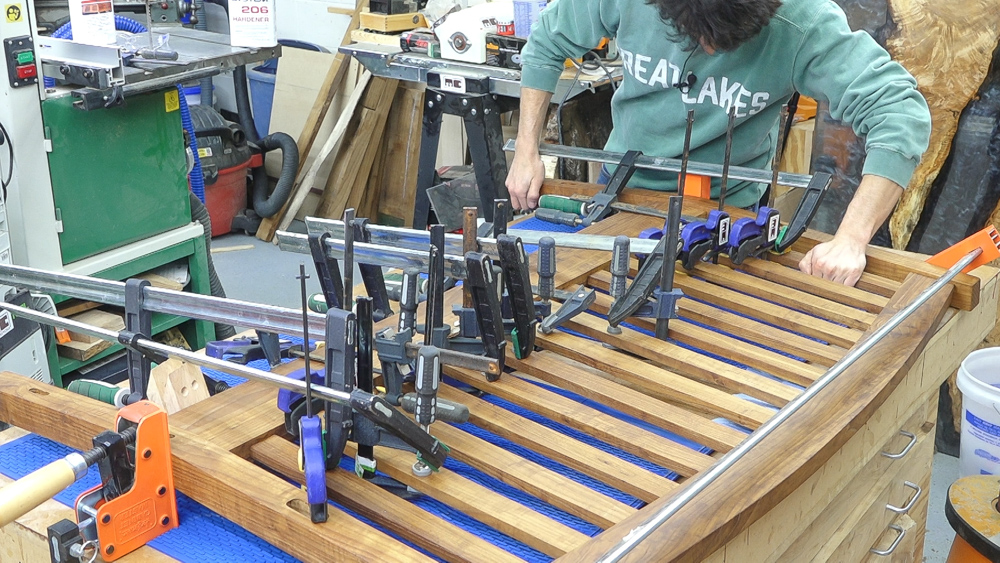
I let the pieces sit for a few days before starting the glue up. I’m using epoxy for this glue up because of it’s long working time and because it’s not a water based glue. Waterbased PVA glues aren’t super effective with thermally modified woods because of it’s inherent water resistance. I’m doing the glue up in two phases starting with the entire back assembly. I used clamps on the slats to make sure their tenons were fully pulled into their mortises. I ran out of small clamps quickly.

The next day I could continue the glue up by assembling the remaining parts.

The next day after that glue up had cured, I could attach the seat slats using screws through the holes I had drilled previously.

And with those slats installed, this guy was done.
PRODUCTS USED
[Amazon links are affiliate links]
Router: http://amzn.to/2hXj5AC
Router Table: http://amzn.to/2sbcLLt
Jig Saw: https://amzn.to/2PedA0a
Table Saw: http://amzn.to/2hXj5AC
Bandsaw: http://amzn.to/2HISAf0
Finish: https://amzn.to/2xo0Wsn
Dust Mask: http://amzn.to/2y8dl1m
Hearing Protection: http://amzn.to/2yQ0sa3
West System Epoxy Resin (Gallon): http://amzn.to/25TYH7y
West System Epoxy Slow Hardener (Quart): http://amzn.to/25TYKAr
West System Metering Pumps: http://amzn.to/1qicuEr
Push Blocks: http://amzn.to/2yQD24r
More stuff on my Amazon page: https://www.amazon.com/shop/matthewcremona


Welcome to my shop! This is a quick update to let you know what I’ve been up to. This big chunky thing is the leg

Welcome back to the home renovation. This time I’m going to be working on the kitchen island. Here is a small model of the island.

Welcome back to our home renovation. Today I am going to be working on this wall. It needs some upper cabinets and the surround for
2 Responses
Hello,
I would like to make this bench but don’t see where to purchase the plans?
Can you let me know where I can get them please.
Thank you
Norm
Here’s the link to the class which includes the plans: https://thewoodwhispererguild.com/product/outdoor-bench/